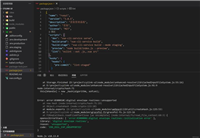在 node.js 开发中,格式化时间是一个常见的需求。例如,将时间格式化为 yyyy-mm-dd hh:mm:ss,或转换为不同的时区。本文将介绍两种格式化时间的方式:使用 javascript 内置方法 和 使用 npm 包 moment,并提供完整的代码示例,帮助开发者更详细地学习和使用。
1. 使用 javascript 内置方法格式化时间
node.js 提供了 date 对象,可以使用 toisostring()、getfullyear() 等方法格式化时间。
示例:使用 date 对象格式化时间
文件名:format_date_native.js(javascript)
// format_date_native.js
function formatdate(date) {
const year = date.getfullyear();
const month = string(date.getmonth() + 1).padstart(2, "0");
const day = string(date.getdate()).padstart(2, "0");
const hours = string(date.gethours()).padstart(2, "0");
const minutes = string(date.getminutes()).padstart(2, "0");
const seconds = string(date.getseconds()).padstart(2, "0");
return `${year}-${month}-${day} ${hours}:${minutes}:${seconds}`;
}
// 获取当前时间并格式化
const now = new date();
console.log("当前时间:", formatdate(now));运行程序
node format_date_native.js
示例输出
当前时间: 2025-03-19 14:30:45
(具体时间根据运行时的系统时间而定)
原理解析
getfullyear() 获取四位年份
- getmonth() 获取月份,返回值是 0-11,所以需 +1
- getdate() 获取日期
- gethours()、getminutes()、getseconds() 获取时间部分
- padstart(2, "0") 用于补零,确保两位数格式
2. 使用 npm 包 moment 进行时间格式化
虽然 date 对象可以手动格式化时间,但 moment.js 提供了更简洁的方式。
安装 moment
npm install moment
示例:使用 moment 格式化时间
文件名:format_date_moment.js(javascript)
// format_date_moment.js
const moment = require("moment");
// 获取当前时间并格式化
const formattedtime = moment().format("yyyy-mm-dd hh:mm:ss");
console.log("当前时间:", formattedtime);
运行程序
node format_date_moment.js
示例输出
当前时间: 2025-03-19 14:30:45
原理解析
moment() 获取当前时间
.format("yyyy-mm-dd hh:mm:ss") 直接转换为指定格式
3. 两种方法的对比
| 方式 | 优势 | 劣势 |
|---|---|---|
| 原生 date | 无需额外安装,轻量级 | 代码较繁琐,需手动格式化 |
| moment.js | 语法简洁,支持时区、国际化 | 需要安装额外 npm 包 |
4. 结论
- 如果只是简单格式化时间,使用
date对象 也能实现。 - 如果需要 更强大的日期操作(如时区转换、本地化格式),建议使用
moment.js。 - 现代开发推荐使用
dayjs(更轻量的替代moment.js),如果对性能有更高要求可以考虑。
5.知识扩展
1.node.js使用dayjs组件库格式化时间
// 下载 dayjs 组件库
npm install dayjs --save
// 进行引用
const dayjs = require('dayjs')
// 引用的dayjs实例是一个函数返回的实例,可以直接使用。
// 获取到当前时间,格式化(年-月-日 时-分-秒)
let currdate = dayjs().format('yyyy-mm-dd hh:mm:ss');
// 初始化其他时间,格式化(年-月-日 时-分-秒)
let date = new date();
let currdate = dayjs(date).format('yyyy-mm-dd hh:mm:ss'); 2.nodejs中格式化iso日期
在node.js中,可以使用内置的date对象和toisostring()方法来格式化iso日期。
iso日期是一种标准的日期和时间表示格式,它的格式为yyyy-mm-ddthh:mm:ss.sssz,其中:
yyyy表示四位数的年份mm表示两位数的月份dd表示两位数的日期t表示日期和时间的分隔符hh表示两位数的小时数(24小时制)mm表示两位数的分钟数ss表示两位数的秒数sss表示三位数的毫秒数z表示时区偏移量,格式为+hh:mm或-hh:mm
以下是在node.js中格式化iso日期的示例代码:
const currentdate = new date(); const isodate = currentdate.toisostring(); console.log(isodate);
输出结果类似于:2022-01-01t12:34:56.789z
在这个例子中,我们首先创建一个date对象来表示当前日期和时间。然后,使用toisostring()方法将日期对象转换为iso格式的字符串。最后,通过console.log()打印输出iso日期字符串。
需要注意的是,toisostring()方法返回的日期字符串是基于utc时间的。如果需要基于本地时间进行格式化,可以使用其他库或手动处理时区偏移量。
到此这篇关于node.js实现格式化时间的两种方法详解的文章就介绍到这了,更多相关node.js格式化时间内容请搜索代码网以前的文章或继续浏览下面的相关文章希望大家以后多多支持代码网!




发表评论